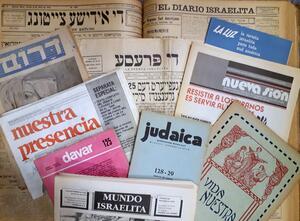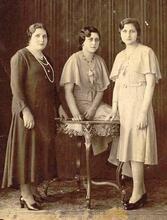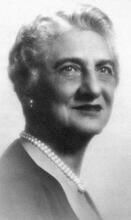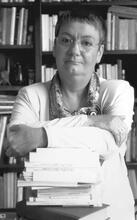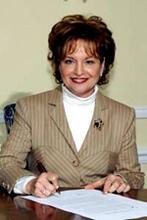Argentina: Zionist Activities
Argentine women participated in the Zionist movement through women’s committees in larger male organizations, as candidates in Zionist parties, and through independent women’s organizations. WIZO-Argentina, founded in 1926, soon became the largest Zionist organization in Argentina (including male organizations). Argentine WIZO women helped female agricultural students in Palestine/Israel through their support of a farm in Afulah. They carried out large fundraising campaigns, organized educational events to spread the Zionist ideal among women, and founded a kindergarten in Argentina to help Argentine Jewish women at home. Other female Zionist organizations also raised funds to help the Yishuv and later Israel. These organizations were important in providing women with spaces to meet other Jewish women and create community.
Argentine Jewish women were important players in the struggle for the Jewish homeland. They participated in women’s committees of Zionist societies, in Zionist political parties, and in three independent women’s Zionist organizations. Among the more prominent women’s committees were the Organización Femenina Sionista General Argentina (of the Partido General Sionista) and the women’s committees of the first and second Sephardi Zionist Centers (founded in 1925 and 1932 respectively). Among individual women who participated in Zionist political leadership as candidates for political parties were Clara Filer, Hadasa Halperin, Judith Isajaroff, and Judith Guinzburg, all candidates for the Poale Sion Histadrut Party in the 1950s. The three independent women’s organizations were WIZO (Women’s International Zionist Organization), the Organización Sionista de Pioneras (Pioneer Zionist Women’s Organization) and the Orthodox Women’s Mizrahi.
The Foundation of WIZO Argentina
WIZO Argentina, by far the largest and most famous of women’s Zionist organizations in Argentina, was founded in 1926 (Argentina being one of the first eight countries in the world to establish a branch). Yet women’s participation in the Zionist movement dated from the very first years of the twentieth century. There is evidence of several female Zionist groups in Buenos Aires before 1926: the Association of Zionist Women Débora (belonging to the Dr. Herzl League); Zirungs Fond, a group that raised money to buy land in Palestine; the women’s committee of the Jewish National Fund, and the women’s committee of the first Sephardi Zionist Center. These early women’s groups, however, were viewed as fundraising arms of the existing (male-dominated) Zionist organizations.
In its last session in 1926 before the women’s committee of the Jewish National Fund became independent and affiliated with WIZO, Cecilia Gruman spoke about her recent visit to Palestine (1925?). In particular, she was impressed by the work done at a women’s farm near Rishon le-Zion. She explained to her audience that although the farm had received the land from the Jewish National Fund and the Keren Hayesod (United Israel Appeal) had helped build a small facility, the number of young women waiting to enter the farm and live on its grounds was growing. It was therefore necessary, she claimed, to build a “brick and cement” house, acquire an irrigation system, and buy more land on which the women could engage in farm work. So impressed was Gruman with this work that she promised the female leaders of the farm that the Argentine committee would help them in their project.
After hearing Gruman’s impassioned description, the Comité confirmed her promise and decided that they would begin a campaign on behalf of the farm. This project was never put into effect, since in their next meeting the Comité de Damas del Fondo Nacional became the Organización Sionista Femenina affiliated with WIZO, whose work was directed by the world offices in London (and later Tel Aviv). Yet this simple anecdote proves that even before they became part of the WIZO project (which included helping women and children in Palestine), this group of Argentine Jewish women had already decided they would no longer be merely a fund-raising committee of the male organizations. Rather, they took it upon themselves to perform other activities, to raise money for projects they, as women, believed were necessary.
The Organización Sionista Femenina (later to become OSFA, and popularly known simply as WIZO) became part of world WIZO during the visit of the Bensións to Argentina in 1926. Ida Bensión, the Canadian wife of Dr. Ariel Bensión (1881–1932) (who had traveled on behalf of the World Zionist Organization to Argentina to organize the Descendants of the Jews who lived in Spain and Portugal before the explusion of 1492; primarily Jews of N. Africa, Italy, the Middle East and the Balkans.Sephardim living there) was instrumental in bringing already existing women’s Zionist groups under the auspices of world WIZO. During the couple’s visit to Rosario, Province of Santa Fé, Ida Bensión turned the existing women’s committee of the local Zionist society into the Círculo de Damas Sionistas, which affiliated with WIZO on November 2, 1926. The creation of a women’s center in Mendoza also took place during the Bensións’ stay. Before the Bensións’ departure for Palestine at the end of November, WIZO had set firm roots in Argentine soil. In WIZO’s first Memoria y Balance (Financial Report) published in 1927, the Argentine Jewish women listed two centers in Buenos Aires, one in Mendoza, and one in Rosario, as well as a group in Tres Arroyos and another in Bahia Blanca (both towns in the Province of Buenos Aires). In Buenos Aires, in the first year of the group’s existence, the founding members had managed to enlist almost five hundred members, among them a very small number of Sephardi women. Sephardi women’s participation within WIZO groups was not significant, as WIZO meetings tended to be conducted in Yiddish, a language they did not speak or understand. This would change when Sephardi women created their own chapters.
The Spread of WIZO Argentina
As WIZO became more popular, centers were created in almost all cities with a Jewish population. In 1941, there were 108 centers, a number which grew to 171 by 1946. With the creation of the State of Israel in 1948, the number of centers grew to 220 with a total of 22,000 members. In 1961, the number of centers had again risen, to 338, with a total membership of 38,014. WIZO was by far the largest single Zionist organization, male or female, in Argentina.
The organizational structure developed as WIZO Argentina grew. At the Third National Convention in 1938, Ida Bensión (during another visit to Argentina) initiated the creation of a central executive committee in Buenos Aires and the division of the rest of the country into regional centers. Among the women who presided over WIZO Argentina were Rebeca Rubistein, Sofia Nissensohn, Berta Gerchunoff, Amalia Polack, and Aída Margulies.
The activities of WIZO were varied. Locally, the organization focused on spreading Zionist ideals and Jewish culture among women. In 1935, the executive began publishing a monthly magazine entitled OSFA, which included not only news about The Land of IsraelErez Israel, but also general information about Jewish festivals, Jewish history, and Zionist personalities. The magazine became one of the most important sources of information and dissemination of the work being done both locally and in Palestine. The Department of Culture of the Executive sponsored cultural seminars and courses on Hebrew, Bible, and prayer. Fundraising events were usually organized around cultural activities such as lectures, round-table discussions, and debates. The famous “chain-teas” (tes en cadena), ongoing tea parties in the homes of members of the WIZO, became well known among Jewish women; even while chatting and playing cards, women would usually read some material related to Jewish and Zionist topics.
In time, other departments were created. In 1936, the Young WIZO was formed; in 1938, a library and kindergarten were founded in Buenos Aires, and sewing shops were created in all centers of the country; a tourism department, which sponsored trips to Israel that included visits to WIZO institutions, was established in the late 1950s.
Money to support their work was obtained through various campaigns and methods. An annual campaign, which set the tone for the work of the whole year, was usually conducted under “a slogan concerning the most urgent necessity in Israel.” Each region was responsible for raising its share for the campaign. This amount was collected by the various centers, which decided what activities to sponsor. In addition to working on the campaign, members paid a monthly minimum membership fee, a WIZO shekel paid once a year (the fee for membership in the World Zionist Organization), and the magazine fee (if they wished to subscribe to it). Each member (called chaverah, or friend) also received a “WIZO flower” on her birthday, which she would accept, giving a contribution to show her thanks. If a member went on vacation, she would donate the amount that she would spend on two vacation days. The WIZO fund, another source of income, was made up of the income from various functions, Shavuot dinners, and the sales of WIZO napkins, New Year cards, and pins.
WIZO also contributed to the Keren Kayemet Le-Israel (Jewish National Fund) by selling trees, inscribing a person’s name in the Golden Book, and collecting money after the birth of babies, weddings and bnei mitzvah. They were also in charge of distributing and emptying the famous blue and white collection boxes. WIZO was represented in the Keren Kayemet Le-Israel, Keren Hayesod, and (after 1949) the United Campaign organized by all the Zionist groups in Argentina. After 1952, the organization managed to obtain three seats in the Argentine Zionist Organization Conventions: the first vice presidency, and two voting memberships. In addition, three presidents of OSFA were elected to the vice presidency of DAIA (Delegación de Asociaciones Israelitas Argentinas).
WIZO Argentina and Afulah Farm
WIZO Argentina’s concrete work in Palestine focused on the support of a farm and on shipping materials needed in schools and kindergartens. In their first Memoria y Balance, which described their accomplishments during their first year of work (1926–1927), they announced that they would be in charge, in the name of the Organización Sionista Femenina Argentina, of the construction of a house in Afulah, a farm supported by World WIZO. Afulah replaced the original commitment to help the farm Cecilia Gruman had visited in Rishon le-Zion, and it soon became the “practical work” that connected the Argentine Zionist women to Palestine and the work for the redemption of the land.
Afulah became a powerful symbol for Argentine Jewish women. During the last three months of every year, WIZO focused on the “Building Month” campaign, whose purpose was to raise funds to continue building the farm. Several of the centers in the provinces decided to defray the cost of specific items (WIZO Rosario, for example, promised to pay for the construction of a building to house the milking equipment and for the furniture of the farm house). In subsequent years, WIZO took on the responsibility of raising a fixed amount of money for the upkeep of the farm but also responded to urgent calls for new additions when needed.
The activity on the farm and how the money raised by WIZO Argentina helped the farm’s women and children were common topics for the organization’s magazine. In letters sent by the Argentine women to the central offices in Tel Aviv, they constantly requested photographs of the farm that could be used as propaganda during meetings and for poster boards. Concrete evidence of how funds raised by the women in Argentina were affecting the lives of women and children in Israel was crucial for keeping women active in their cause.
Another issue that was very important in mobilizing such a large number of women into action was the use of a discourse that lacked any reference to politics. Zionism was a highly politicized arena, with many groups in a widely diverse spectrum. Yet “working for the WIZO is not the same as working in politics,” claimed Fanny Wachs, one of the outstanding presidents of WIZO Rosario, when trying to recruit new members. “It is the duty to cooperate in the realization of an ideal.” This absence of references to politics as an abstract realm, as well as the concrete nature of their work, ensured the participation of a large and diverse group of women.
Although the issue of language initially prevented Sephardi and German Jews from participating actively in the Zionist arena (until relatively late, most events late were conducted in Yiddish), Argentine Jewish women solved this potentially divisive question by creating a German-speaking Central European group and a Spanish-speaking Sephardi group. By 1948, the German sector, led for twenty years by Lisbeth Wind, had founded eight centers and had mobilized six hundred members. By 1948, the Sephardi sector, created in 1946 and for many years led by Alegre Bonomo, had created four centers in Buenos Aires, Córdoba, Tucumán, and Paraná, and had mobilized five hundred women (see Argentina: Sephardi Women).
Other Zionist Organizations
Very little information is available on the other women’s Zionist organizations. The Pioneer organization was founded in 1948 when the Comité Amigas de la Histadrut (friends of the Histradrut) declared its solidarity with the Council of Women Workers in Israel, a fact which may indicate that the Amigas de la Histadrut committee had already been active before that date. More political in its stance than WIZO, this group organized talks, seminars, and public events, at which they presented Jewish and Zionist topics. By 1960 they had created more than twenty centers in all of Argentina. Pioneers participated actively in the life of the Jewish community sending delegates to the meetings of the major Jewish Argentine organizations: the AMIA (Asociación Mutual Israelita Argentina), the DAIA (Delegación de Asociaciones Israelitas Argentinas), Keren Kayemet, and the OSA (Organización Sionista Argentina). A Sephardi branch of the Amigas de la Histadrut was founded in 1945, thanks to the untiring energy of Judith Isajaroff, a Sephardi woman from Samarkand. By 1947 the organization claimed to have mobilized five hundred Sephardi women into spreading the Zionist ideal, cooperating with the Jewish National Fund, creating sewing workshops and attracting young people.
Since the late 1970s, the number of women participating in WIZO activities and in the Amigas de la Histadrut has declined. Once women entered the job market, it became harder to juggle professional and family life, leaving little time and energy for other activities. What once was one of the most popular Jewish women’s cultural activities has now become only one of the many scenes in which women can and do participate. Yet a less active present should not obscure the fact that Jewish women in Argentina were eager actors in the fight for the Jewish homeland, and by being so involved in the project they consolidated a strong presence on the Argentine (and international) Jewish scene.
Brodsky, Adriana. "Electing 'Miss Sefaradí,' and 'Queen Esther': Sephardim, Zionism, and Ethnic and National Identities in Argentina, 1933-1971." In The New Jewish Argentina: Facets of Jewish Experiences in the Southern Cone, edited by Raanan Rein and Adriana Brodsky, 179-211. Leiden: Brill, 2012.
Brodsky, Adriana. Sephardi, Jewish, Argentine: Community and National Identity, 1880-1960. Bloomington, IN: Indiana University Press, 2016.
Deutsch, Sandra McGee. Crossing Borders, Claiming a Nation: A History of Argentine Jewish Women, 1880-1955. Durham: Duke University Press, 2010.
Elnecavé, Bruria. Crisol de Vivencias Judías. Buenos Aires: Ediciones La Luz, 1994.
Laznow, Jacqueline. "'La Jalutzah del Galuth': Fundraising and Women's Folk Creativity among OSFA-WIZO Members in Argentina. Nashim: A Journal of Jewish Women's Studies and Gender Issues 35 (2019): 7-39.
Visacovsky, Nerina. "La identidad política de las mujeres judeo-argentinas (1947-1957)." In VCongreso Latinoamericano de Ciencia Política. Buenos Aires: Acta Académica, 2010.

